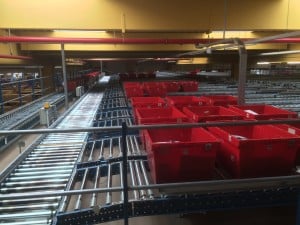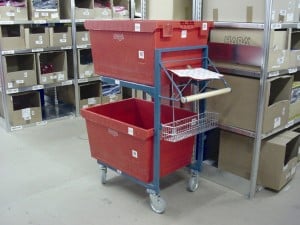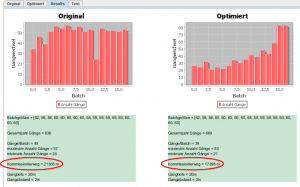In order to achieve further optimizations in the order picking logistics of the Habermaaß Group, TUP has implemented a reservation optimization with the program module RES. The optimized order scheduling controlled by this module made it possible to achieve significant reductions in picking routes after only a few weeks. This is a very significant benefit in peak times with up to 40,000 orders per day, for which up to 60 order pickers are involved.
by Reinhard Irrgang
“With RES, a new program module of the Manual Sort Order Picking system introduced by TUP around ten years ago, the fundamental issue is how orders can be optimally loaded into the system,” says Christian Müller, Head of Process Management IT/Logistics at Habermaaß, Bad Rodach: “Up to now, we had stochastically combined orders from the order pool to be processed in each case into commissions of 60 orders each, according to certain grouping criteria. We then planned and provided supplies for these commissions and their contents. Thus the probability was relatively high that each commission contained orders that required replenishment. In addition, we didn’t know where the pick positions were at the time, because the replenishment was positioned where there was room, according to the stochastic storage principle.
When optimizing reservations with the new RES module from TUP, “the entire previous planning was turned upside down, because we are now planning with the orders in stock”. RES selects the orders that do not require replenishment, as the goods for these orders are already completely available in the picking process, and forms the batches for these orders.
For those orders that need replenishment, this is placed in the picking as a precaution. The decisive factor is that with RES support, only those orders for which replenishment is no longer required are loaded into the picking process.

Müller explains the procedure in detail: In the first stage of the RES in the HLS (Habermaaß Logistics System), the orders for which no replenishment is required are taken and picks with a maximum of 60 orders are formed, prioritized according to the picking formation parameters.
In a second stage, the orders are transferred parameter-controlled from the HLS to the module of the MSK (manual sort picking). There, a mathematical algorithm is used for further optimization and orders are again exchanged and optimized between the pickers of a group along their routes.
Since, in contrast to the past, the pick positions of the orders or order components are now known, the orders can be combined to form significantly route-optimized picking routes for the order pickers. In this way, RES ensures very consistent order picking, a uniform workflow and significantly shorter walking distances. These optimizations are performed fully automatically by the system.
Picking extends over two levels and is divided into ten supply zones, as Müller explains: “Since we pick for different clients and thus companies and brands, we need these supply zones in order to keep the assortments of the clients concerned somewhat more compressed and thus to be able to shorten the routes so that the entire picking areas do not have to be traversed. RES also had to consider this specific structure.
Dynamic picking preparation for two-shift operation
In logistics, Habermaaß works in two shifts, but there are no predefined times when the system’s algorithms run for the optimization processes. Instead, fill level parameters indicate when the order volume in picking falls below a defined minimum; if this is the case, the system immediately replenishes to the maximum.
This process is “very dynamic”, as Müller emphasizes: “If many order pickers are used and can therefore process the orders quickly, the algorithm calculates more frequently. The replenishment is permanent and continuous”.
However, in order to achieve this dynamic, it was necessary to limit the duration of the algorithm’s computing time in order to avoid too long waiting times caused by system-side computing operations. Müller: “It makes little sense if the algorithm would calculate two or three hours and the picking runs empty because no new orders are issued. So you have to “tell” the algorithm by parameter after which time period the algorithm should abort the optimization calculation to ensure that the work is loaded evenly into the picking process.
Introduction of RES during running operation

The modernization with RES was carried out during ongoing operation. “Fortunately, we had little to do with the introduction of the system during ongoing operation,” says Müller. TUP took care of this. Since it was a matter of adapting the scheduling strategy in the software itself, TUP carried out the programming at its own premises, then rolled it out on a test system and tested it in detail.
“We then introduced RES in two steps: In the first step, we changed over to a situation where we already plan in stock and only pass on to the MSK module those orders that we know no longer need to be replenished,” explained Müller further.
The second step was optimization in the MSK module itself, so that the orders can once again be optimally combined into a batch on the basis of the known pick positions.
RES was put into live operation over a weekend in mid-November 2015 after acceptance of the tests, and “then we still had to rework two or three small things in real operation, so all in all a comparatively small amount of work,” emphasizes Müller.
Only a minimum of employee training was required. As Müller reports, the control center employees were trained because the shift managers have to act somewhat differently with the modified scheduling. The picking employees do not notice anything about RES. They still receive their sequence-optimized pick-label sheets and work through the corresponding positions.
Walking distances shortened by 15 percent after only four weeks of system use

The experience with RES so far is very positive. As early as mid-December 2015, just under four weeks after the system was commissioned, the number of aisles to be approached in a batch was reduced by around 15 percent. This corresponds to about 8% less actual routing in order picking. “Interestingly, this is roughly the value we calculated with our data during the simulation before the new module was introduced,” says Müller.
As he explains, “With a little support and warehouse management, I think we could perhaps achieve 20 percent, but much more will not be possible. After all, we have a total of around 95,000 different items in stock,” with the spectrum ranging from the smallest parts such as erasers and pencils to packed furniture.
Of these 95,000 articles, almost 40,000 are in the order picking process. Thus, RES is also tailored to the main picking warehouse. Each article here has a physical space requirement of about 1.3 spaces.
At peak times up to 40,000 orders per day
A glance at the order figures shows the potential for optimization offered by the shortened routes in order picking. In peak times, for example, around 20,000 to 25,000 orders per day are processed, and on an absolute peak day in the Christmas season, around 40,000 orders were once processed. 20,000 to 25,000 orders mean a dispatch quantity of 130,000 to 140,000 parts, which are dispatched in around 25,000 packages per day.
During the peak season, between 40 and 60 order pickers are employed.
In addition, as Müller emphasizes, “no two years can be compared with each other, also in terms of order dispatch and items. We continuously have a lot of new products in our range and, especially in the fashion sector, a lot of seasonally driven articles. That’s why we were already thrilled that we received this 15 % improvement with regard to the aisles to be served right away. Because”, Müller knows, “normally you only get this if you have a clean ABC classification and very thorough warehouse management. That’s why it’s so special that this worked out for us right away.
The advantage is that what Müller calls “wave movements”, which occur when replenishment has to be triggered and cannot be made available quickly enough, are now a thing of the past, and as a result, the picking “runs dry”. Since RES only loads the order picking system with what is actually available, it runs much more smoothly and is significantly optimized.

“Sometimes you simply have to dare to solve a task mathematically,” emphasizes Eduard Wagner, Senior Project Manager and member of the extended management team at TUP. “The RES module is a mathematical optimization module and was developed at TUP by mathematicians with doctorates and experienced computer scientists. The long-standing cooperation between Haba and TUP has given both parties the confidence that a fundamental rethink of a central core process such as order dispatching can deliver a high potential for improvement. The simulation of the solution approaches has confirmed the expectations, and the successful live operation has more than rewarded the courage to change”.
Reinhard Irrgang

